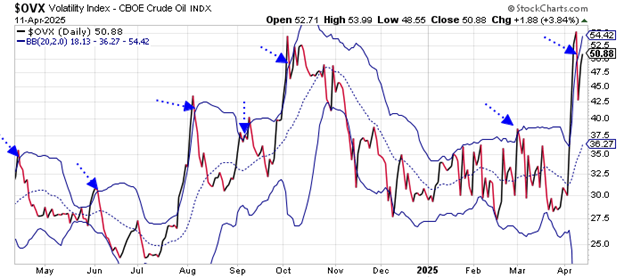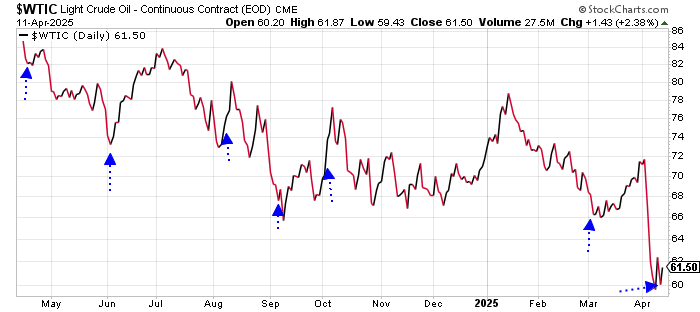It’s time to buy oil.
The price of the gooey, black stuff has been crushed – falling from over $78 per barrel in early January to as low as $60 last week.
The “experts” are bearish. They’re pointed to bloated inventories and fears of a global recession. And they’re telling us the price of oil is headed lower.
But my favorite oil trading indicator just flashed a “buy” signal.
So, I’m ignoring the “experts” and suggesting oil will be trading higher over the next several weeks.
Take a look at this chart of the CBOE Crude Oil Volatility Index (OVX) along with its Bollinger Bands…
 Similar to the stock market’s Volatility Index (VIX), the OVX provides buy and sell signals whenever the price of oil pops outside of its Bollinger Bands (solid blue lines).
Similar to the stock market’s Volatility Index (VIX), the OVX provides buy and sell signals whenever the price of oil pops outside of its Bollinger Bands (solid blue lines).
Bollinger Bands measure the most probable trading range for a stock or an index. When a chart pokes outside of its Bollinger Bands, it indicates an extreme move – one that is likely to reverse.
On the OVX chart, we get buy signals when the index rallies above its upper Bollinger Band.
We’ve had six previous buy signals (blue arrows) over the past year.
Here’s how the price of oil behaved following those signals…
 The price of oil rallied immediately following all previous buy signals over the past year (blue arrows).
The price of oil rallied immediately following all previous buy signals over the past year (blue arrows).
Sometimes the rallies were significant, lasting several weeks – like the rally in June that pushed oil 15% higher in five weeks. Sometimes the rally ran out of fuel within just a few days – like the April buy signal which produced a measly 2% gain.
But in every case, it was better to be a buyer of oil than it was to be a seller when the OVX generated a buy signal.
Early last week, the OVX closed above its upper Bollinger Band. It closed back inside the bands on Thursday. So, we have a new buy signal for oil.
And based on the previous success of this indicator, traders should be looking for higher oil prices in the days and weeks ahead.
Best regards and good trading,
Jeff Clark
NEW THIS WEEK: Huge Energy Discovery In Utah [sponsor]The Department of Energy say it could power America for millions of years. And both grizzled oilmen and clean energy supporters love it: Energy Secretary Chris Wright called it "an awesome resource," while Warren Buffett, Jeff Bezos, Mark Zuckerberg, and Bill Gates are all directly invested. Here's the name of the company at the heart of it all.
Source: Jeff Clark Trader
